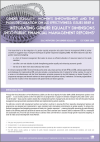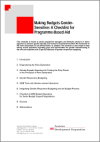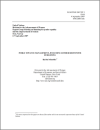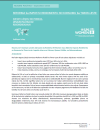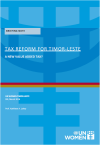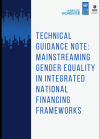FOUND 18 RESULTS
This Issues Brief published by the DAC NETWORK on Gender Equality in October 2010 is on the integration of a gender equality perspective into public financial management (PFM) in partner countries. It suggests ways of using the techniques of gender-responsive budgeting (GRB). The Brief makes the case that gender responsive budgeting: is a form of financial management that seeks to ensure an efficient allocation of resources based on the needs identified can offer a win-win situation by both...
This checklist is meant to assist programme managers and thematic advisors in donor agencies to advance gender equality and women's empowerment within the framework of the Paris Declaration on aid effectiveness. It is also meant to help in asking crucial questions regarding gaps and opportunities for gender mainstreaming in the new aid modalities with a special emphasis on gender responsive budgeting. The document was published by the Austrian Development Cooperation in 2009.
This paper explains what GRB is, what GRB work has help achieved and how it can further contribute to achieving gender equity and equality. The paper also presents some of the challenges of doing GRB work and concludes with a set of recommendations to institutionalize a gender equality perspective in public finance.
Rezumu ne’e hanesan sumáriu ida bazeia ba Relatóriu UN Women nian, Reforma Impostu Rendimentu no Konsumu ba Timor-Leste: Impaktu Jéneru no Pobreza, Opsaun Polítika, no Rekomendasaun.
Governments raise tax revenues so that they can meet the needs of the people they represent. Fair and equal taxation makes sure that tax laws do not discriminate against people who live traditional lives, subsistence farmers, rural business owners, women, or the poor
Integrated national financing frameworks (INFFs) were first introduced in the Addis Ababa Action Agenda to support increased alignment of financing from all sources with national sustainable development objectives. The technical guidance aims to support countries to integrate gender equality objectives and gender analysis into the design and implementation of INFFs.
'The State of Gender Lens Investing' presents a survey of the current state of the field, makes sense of tensions and trends in the field and recommends directions and action by a wide variety of participants, such as philanthropists, investors, nonprofit leaders, policymakers, entrepreneurs, activists and academics.
This book aims to contribute to the evolving understanding of public expenditure management as a political, rather than a purely technical, process. In particular, it explores the ways in which a rights approach can contribute to strengthening pro-poor voice and outcomes in budget processes. It identifies issues, partners, tools and methods that may help development actors to support citizen accountability and a pro-poor, gender-equitable, focus in public expenditure management.
